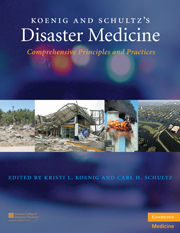Book contents
- Frontmatter
- Contents
- List of Contributors
- Contributor Biographies
- Foreword
- Preface
- Acknowledgments
- PART I CONCEPTUAL FRAMEWORK AND STRATEGIC OVERVIEW
- 1 Disaster Research and Epidemiology
- 2 Disaster Education and Training: Linking Individual and Organizational Learning and Performance
- 3 Surge Capacity
- 4 International Perspectives on Disaster Management
- 5 Ethical Issues in Disaster Medicine
- 6 Emerging Infectious Diseases: Concepts in Preparing for and Responding to the Next Microbial Threat
- 7 Disaster Mental and Behavioral Health
- 8 Special Needs Populations
- PART II OPERATIONAL ISSUES
- PART III CLINICAL MANAGEMENT
- Index
- Plate section
- References
3 - Surge Capacity
from PART I - CONCEPTUAL FRAMEWORK AND STRATEGIC OVERVIEW
Published online by Cambridge University Press: 05 August 2011
- Frontmatter
- Contents
- List of Contributors
- Contributor Biographies
- Foreword
- Preface
- Acknowledgments
- PART I CONCEPTUAL FRAMEWORK AND STRATEGIC OVERVIEW
- 1 Disaster Research and Epidemiology
- 2 Disaster Education and Training: Linking Individual and Organizational Learning and Performance
- 3 Surge Capacity
- 4 International Perspectives on Disaster Management
- 5 Ethical Issues in Disaster Medicine
- 6 Emerging Infectious Diseases: Concepts in Preparing for and Responding to the Next Microbial Threat
- 7 Disaster Mental and Behavioral Health
- 8 Special Needs Populations
- PART II OPERATIONAL ISSUES
- PART III CLINICAL MANAGEMENT
- Index
- Plate section
- References
Summary
“On March 11th, 1918 – an Army private reported to the camp hospital before breakfast. He had a fever, sore, throat, headache…nothing serious. One minute later, another soldier showed up. By noon, the hospital had over a hundred cases; in a week, 500…Over 11,000 people would die in Philadelphia alone that October…In 31 shocking days, the flu would kill over 195,000 Americans. It was the deadliest month in this nation's history”. It was not only happening in the United States, it was happening all over the world.
Developing the capacity and capability to handle a rapid increase in demand for patient care and public health services related to disasters or significant events impacting the healthcare community has become known as medical surge. The need for surge capacity is characterized by a mismatch between patient care needs and the capability and/or capacity to fill those needs during a catastrophic medical event. Figure 3.1 demonstrates a national response. Health and medical needs rise sharply after an event. Local response rises to meet the demand but becomes exhausted and begins to degrade after 24 hours. Preincident capacity for routine services is reduced in the immediate aftermath of a disaster. National and other external resources are activated and arrive after approximately 72 hours. The gap in requirements or needs compared with the capability is the surge requirement.
Keywords
- Type
- Chapter
- Information
- Koenig and Schultz's Disaster MedicineComprehensive Principles and Practices, pp. 33 - 50Publisher: Cambridge University PressPrint publication year: 2009



